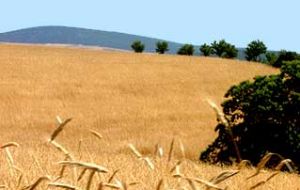MercoPress. South Atlantic News Agency
FAO forecasts second-highest record cereals crop for 2009/10
 The cereals bumper crop had also facilitated replenishment of global reserves to pre-crisis levels.
The cereals bumper crop had also facilitated replenishment of global reserves to pre-crisis levels. With the second-highest recorded cereals crop expected this year and stocks replenished, the world food supply looks less vulnerable to shocks than it was during last year’s food crisis, FAO said in its Food Outlook report published this month. But some potential dangers remain, it also noted.
“In spite of strong gains in recent weeks, international prices of most agricultural commodities have fallen in 2009 from their 2008 heights, an indication that many markets are slowly returning into balance,” the twice-yearly report said.
Apparent easing of market conditions was reflected in the benchmark FAO Food Price Index, which had fallen by one third since its peak in June 2008 at the height of the world food crisis.
But food prices remained high in many developing countries, and access to food by the poor also continued to be threatened by loss of employment, income and other effects of the global economic crisis.
Critical sector
So far the improvement largely concerned cereals – the critical sector for food security – after record production in 2008 overshot original forecasts, the report said. The bumper crop had also facilitated replenishment of global reserves to pre-crisis levels.
“With the new 2009-2010 marketing season commencing, prospects continue to be positive as world cereal production is expected to be the second largest, after last year’s record,” it added. World production was forecast at 2 219 million tonnes as compared with 2 287 million tonnes in 2008/09.
FAO first forecast for world cereal utilization in 2009/10 suggested a relatively weak growth of around 1.3% from the estimated 2008/09 level, to 2.230 million tonnes. This compared with nearly 4% growth in the previous season.
First forecasts
First forecast for world cereal trade in 2009/10 was 257 million tonnes, down by nearly 4% from last year. This contraction mostly concerned wheat imports, which could fall by as much as 10 million tonnes in the new season, reflecting a strong anticipated recovery in production in several major wheat-importing countries.
More problematic was the oilseed products sector, with prices on world markets increasing as a consequence of production setbacks in some major producers and of expanding consumption of animal feed in China and India. Oilseeds production in 2008/09 was forecast at 405.9 million tonnes, 0.7% more than the 403.1 million tonnes estimated for the year before.
“The surge in soybean quotations in recent weeks, on the back of shrinking world reserves, is emerging as a cause for concern given its strong bearing on food and feed prices,” Food Outlook noted.
Sugar demand up, meat and milk down
World sugar consumption was set to expand, albeit at a slower rate than in the past two years, propelled by sustained demand in the developing countries. As a result, consumption was expected to outstrip 2008/09 production of 158.5 million tonnes for the first time since 2005/06, bringing global carry-over inventories down.
On the other hand fish, meat and milk prices have tumbled, driven down by faltering demand as economies slowed and by recurring outbreaks of animal diseases. Prices have plummeted in the dairy sector in particular.
Import savings
And while a welcome development was that falling prices were expected to save importing countries as much as 226 billion in food imports in 2009 as compared with 2008, “the deteriorating economic environment ... could offset much of the benefit,” the report warned.
Eroding purchasing power through a combination of falling incomes and real exchange rates over much of the past 12 months afflicts the affordability of food, however cheap it has become on the international marketplace, it said.
Concern had now shifted from high food prices to the global economic downturn’s potential impact on demand for food, especially higher-value-products, Food Outlook said. But growing linkages between the agricultural sector and the energy, financial and currency markets made food prices increasingly vulnerable to external shocks.
Upward pressure
Specifically, a continuation of the weakening of the US Dollar and the sharp rebound in energy prices witnessed in recent weeks could exert renewed upward pressure on international prices, the report cautioned.
“However, barring major crop setbacks, with world staple food stocks at more comfortable levels than in 2008, the food economy looks less vulnerable to those external developments than it was last year,” the report added.




Top Comments
Disclaimer & comment rules-

Read all commentsA bazillion hungry people, but the second largest harvest in history, being reported by the same agency. The non existing food crisis has passed. Now if they can just do something about Global Cooling.
Jun 21st, 2009 - 06:57 pm 0Commenting for this story is now closed.
If you have a Facebook account, become a fan and comment on our Facebook Page!